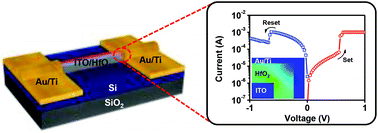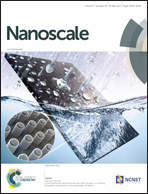Resistive switching of Sn-doped In2O3/HfO2 core–shell nanowire: geometry architecture engineering for nonvolatile memory†
Abstract
Core–shell NWs offer an innovative approach to achieve nanoscale metal–insulator–metal (MIM) heterostructures along the wire radial direction, realizing three-dimensional geometry architecture rather than planar type thin film devices. This work demonstrated the tunable resistive switching characteristics of ITO/HfO2 core–shell nanowires with controllable shell thicknesses by the atomic layer deposition (ALD) process for the first time. Compared to planar HfO2 thin film device configuration, ITO/HfO2 core–shell nanowire shows a prominent resistive memory behavior, including lower power consumption with a smaller SET voltage of ∼0.6 V and better switching voltage uniformity with variations (standard deviation(σ)/mean value (μ)) of VSET and VRESET from 0.38 to 0.14 and from 0.33 to 0.05 for ITO/HfO2 core–shell nanowire and planar HfO2 thin film, respectively. In addition, endurance over 103 cycles resulting from the local electric field enhancement can be achieved, which is attributed to geometry architecture engineering. The concept of geometry architecture engineering provides a promising strategy to modify the electric-field distribution for solving the non-uniformity issue of future RRAM.



 Please wait while we load your content...
Please wait while we load your content...